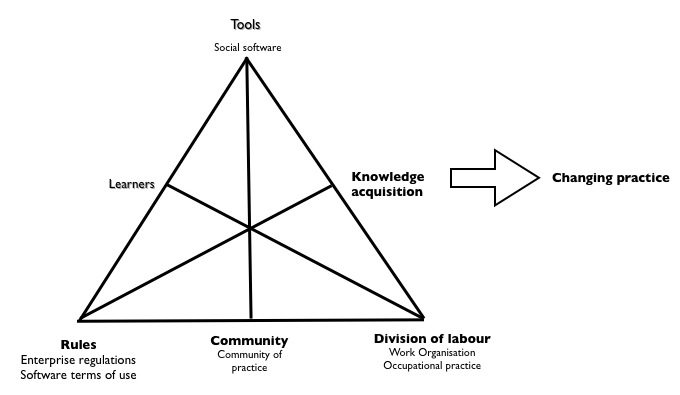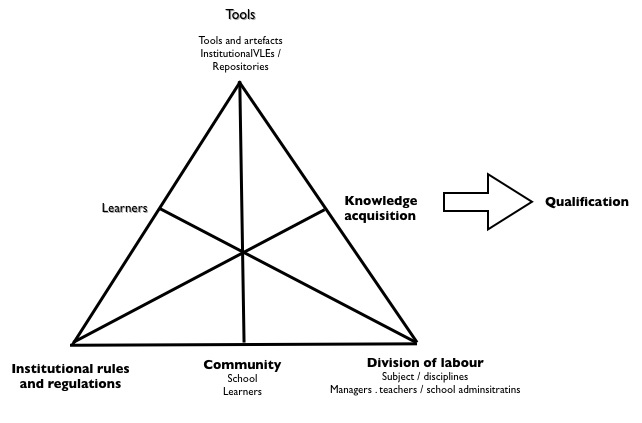I have been invited to particpate in a workshop on ‘Technology Enhanced Learning in the context of technological, societal and cultural transformation‘, being sponsored by the EU funded Stellar Network of Excellence at Garnisch in Germany at teh start of December. I am contributing to a session on Work Based Learning and have written a short position paper on the subject, a draft of which is reproduced below. I have to say I am very much impressed with the work of the London Mobile Learning Group and my paper attempts to look at the idea we have developed for a Work Oriented MoBile Learning Environment (WOMBLE) through the Mature-IP project in the light of their framework for a socio-cultural ecology for mobile learning.
1. A socio-cultural ecology for learning
In his paper, The socio-cultural ecological approach to mobile learning: an overview, Norbert Pachler characterises current changes in the world from a perspective on mobile learning as “akin to social, cultural, media related, technological and semiotic transformation”. The world around us, he says, is “marked by fluidity, provisionality and instability, where responsibilities for meaning making as well as others such as risk-taking have been transferred from the state and institutions to the individual, who has become a consumer of services provided by a global market”. The paper, based on conceptual and theoretical work being undertaken by the London Mobile Learning group, proposes a socio-cultural ecology for learning, based on the “new possibilities for the relationship between learning in and across formal and formal contexts, between the classroom and other sites of learning.” Such an ecology is based on the interplay between agency, cultural practices and structures.
In this short discussion paper, we will consider the possibilities for such an ecology in the context of work-based learning. In particular, we will examine work being undertaken through the EU funded Mature-IP project to research and develop the use of a Work Oriented MoBile Learning Environment (Womble) to support learning and knowledge maturing within organisations.
2. Work-based Learning and Technology
Although it is hard to find reliable quantitative data, it would appear that there has been a steady increase in work-based learning in most countries. This may be due to a number of reasons: probably foremost in this is the pressures for lifelong learning die to technological change and changing products, work processes and occupational profiles. Work-based learning is seen as more efficient and effective and facilitates situated learning. The move towards work-based learning has been accompanied in many countries by a revival in apprenticeship training. It has also been accompanied by a spread of the training function (Attwell and Baumgartl (eds.), 2008), with increasing numbers of workers taking some responsibility for training as part of their job.
The move towards increased work-based training has also been accompanied by the widespread us of Technology Enhanced Learning, at least in larger companies. However, this has not been unproblematic. Technology Enhanced Learning may be very effective where the work processes themselves involve the use of computers. It is also possible to develop advanced simulations of work processes; however such applications are complex and expensive to develop. More commonly, in the classical sense of the dual system, formal Technology Enhanced Learning has been used to support the theoretical side of vocational learning, with practical learning taking place through work-based practice (with greater or lesser face to face support). Given economies of scale, Technology Enhanced Learning has made most impact in vocational learning in those areas with a broad occupational application such as management, sales and ICT. In a previous paper I suggested that the development of technology for learning has been shaped by an educational paradigm, based on an industrial model of schooling developed to meet the needs and forms of a particular phase of capitalist and industrial development and that this paradigm is now becoming dysfunctional. Friesen and Hug argue that “the practices and institutions of education need to be understood in a frame of reference that is mediatic: “as a part of a media-ecological configuration of technologies specific to a particular age or era.” This configuration, they say, is one in which print has been dominant. They quote McLuhan who has described the role of the school specifically as the “custodian of print culture” (1962.) It provides, he says, a socially sanctioned “civil defense against media fallout” — against threatening changes in the mediatic environs.
Research suggests there has been little take up of formal Technology Enhanced Learning in the Small and Medium Enterprises which comprise the greatest growth area in many economies (Attwell (ed.), 2004). However the research, undertaken through an EU funded project into the use of ICT for learning in Small and Medium Enterprises, found the widespread everyday use of internet technologies for informal learning, utilizing a wide range of business and social software applications. This finding is confirmed by a recent study on the adoption of social networking in the workplace and Enterprise 2.0 (Oliver Young G (2009). The study found almost two-thirds of those responding (65%) said that social networks had increased either their efficiency at work, or the efficiency of their colleagues. 63% of respondents who said that using them had enabled them to do something that they hadn’t been able to do before
Of course such studies beg the question of the nature and purpose of the use of social software in the workplace. The findings of the ICT and SME project, which was based on 106 case studies in six European countries focused on the use of technologies for informal learning. The study suggested that although social software was used for information seeking and for social and communication purposes it was also being widely used for informal learning. In such a context:
- Learning takes place in response to problems or issues or is driven by the interests of the learner
- Learning is sequenced by the learner
- Learning is episodic
- Learning is controlled by the learner in terms of pace and time
- Learning is heavily contextual in terms of time, place and use
- Learning is cross disciplinary or cross subject
- Learning is interactive with practice
- Learning builds on often idiosyncratic and personal knowledge bases
- Learning takes place in communities of practice
However, it is important to note that the technology was not being used for formal learning, nor in the most part was it for following a traditionally curriculum or academic body of knowledge.
Instead business applications and social and networking software were being used to develop what has been described as Work Process Knowledge (Boreham, N. Samurçay, R. and Fischer, M. 2002).
The concept of Work Process Knowledge emphasises the relevance of practice in the workplace and is related to concepts of competence and qualification that stress the idea that learning processes not only include cognitive, but also affective, personal and social factors. They include the relevance of such non-cognitive and affective-social factors for the acquisition and use of work process knowledge in practical action. Work often takes place, and is carried out, in different circumstances and contexts. Therefore, it is necessary for the individual to acquire and demonstrate a certain capacity to reflect and act on the task (system) and the wider work environment in order to adapt, act and shape it. Such competence is captured in the notion of “developmental competence” (Ellstroem PE, 1997) and includes ‘the idea of social shaping of work and technology as a principle of vocational education and training’ (Heidegger, G., Rauner F., 1997). Work process knowledge embraces ‘developmental competence’, the developmental perspective emphasising that individuals have the capacity to reflect and act upon the environment and thereby forming or shaping it. In using technologies to develop such work process knowledge, individuals are also shaping or appropriating technologies, often developed or designed for different purposes, for social learning.
3. Knowledge Maturing, Personal Learning Environments and Wombles
MATURE is a large-scale integrating project (IP), co-funded by the European Commission under the Seventh Framework Programme (FP7). It runs from April 2008 to March 2012. The Mature-IP aims to research, develop and test Personal Learning and Maturing Environments (PLME) and Organisational Learning and Maturing Environments (OLME) in promote the agility of organisations. Agility requires that companies and their employees together and mutually dependently learn and develop their competencies efficiently in order to improve productivity of knowledge work. The aim is to leverage the intrinsic motivation of employees to engage in collaborative learning activities, and combine it with a new form of organisational guidance. For that purpose, MATURE conceives individual learning processes to be interlinked (the output of a learning process is input to others) in a knowledge-maturing process in which knowledge changes in nature. This knowledge can take the form of classical content in varying degrees of maturity, but also involves tasks and processes or semantic structures. The goal of MATURE is to understand this maturing process better, based on empirical studies, and to build tools and services to reduce maturing barriers.
The Mature-IP project has undertaken a series of studies looking at learning and knowledge maturing processes within organisations. Based on this work, in year 2 of the project, it is undertaking a series of five Design Projects, developing and testing prototypes of technology based applications to support knowledge maturing within these organisations. One of these projects, the Work Oriented MoBile Learning Environment (Womble), is designed to enable workers to appropriate the mobile phone as a Personal Learning Maturing Environment (PLME) and to support contextualised Work-based Learning, problem-solving, interaction and knowledge maturing via a user owned, mobile PLE.
The design study/demonstrator includes support for structured learning dialogue frameworks, with a social software ‘substrate’ and multi- user / multi-media spaces that will provide workers with the ability to collaborate with co-workers. At the most basic level, Womble services will, for example, allow workers to tag fellow work colleagues (contacts); when a problem arises this service will enable collaborative problem solving. At a more advanced stage a ‘lite’ dialogue game service will be linked to the tagging of personal competencies to scaffold workers in their active collaboration and ‘on the spot’ problem solving.
4. The Womble and a socio-cultural ecology for learning
The conceptual framework proposed by Norbert Pachler and the London Mobile Learning Group (LMLG) proposes a non-hierarchal model based on the interaction between agency, cultural practices and structures. In the penultimate section of this discussion document, we examine how the deign of the Womble matches the framework proposed by the LMLG.
4.1 Agency
Agency is seen by Pachler as “the capacity to deal with and to impact on socio cultural structures and established cultural practices” and “to construct one’s life-world and to use media for meaning making…..”
The aim of the Womble is to develop a “participatory culture” in the workplace including ludic forms of problem solving, identity construction, multitasking, “distributed cognition,” and “transmedial navigation” (Jenkins at al, 2006). It is designed to scaffold developmental competence through sense and meaning making in a shared communicative environment, though exploring, questioning and transcending traditional work structures. Situatedness and proximity are key to such an exploration, the ability to seek, capture store, question and reflect on information, in day to day practice. This the use of the Womble for meaning making goes beyond the exploration of formal bodies of expert knowledge to question manifestations of cultural practice within communities.
A further aspect of agency is the ability to shape the form of the Womble as a user configurable and open set of tools. Wild, Mödritscher and Sigurdarson (2008)suggest that “establishing a learning environment, i.e. a network of people, artefacts, and tools (consciously or unconsciously) involved in learning activities, is part of the learning outcomes, not an instructional condition.” They go on to say: “Considering the learning environment not only a condition for but also an outcome of learning, moves the learning environment further away from being a monolithic platform which is personalisable or customisable by learners (‘easy to use’) and heading towards providing an open set of learning tools, an unrestricted number of actors, and an open corpus of artefacts, either pre-existing or created by the learning process – freely combinable and utilisable by learners within their learning activities (‘easy to develop’). ”
4.2 Cultural Practices
By cultural practices, Pachler, refers to “routines in stable situations both in terms of media use on everyday life as well as the pedagogical practices around teaching and learning in the context of educational institutions.” He points out that the multimodality of mobile and media technologies names: them more difficult to map onto traditional curricula and puts pressure on established canons.”
One key idea behind the Womble is that Personal Learning Environments are owned by the user.But at the same time, the Womble tools are designed to make it easy to for users to configure their environment.
Critically, the pedagogy, if it can be described as such is based on shared practice with learners themselves actively developing learning materials and sharing them through reflection on their context. Whilst such materials might be said to be micro learning materials, the semantic aggregation of those materials, together with advanced search capabilities should provide a holistic organisational learning base. As such the Womble is designed to support , the recognition of context as a key factor in work related and social learning processes. Cook (2009) proposes that new digital media can be regarded as cultural resources for learning and can enable the bringing together of the informal learning contexts in the world outside the institution, or in this case the organisation, with those processes and contexts that are valued inside the intuitions. Cook also suggests that informal learning in social networks is not enabling the “critical, creative and reflective learning that we value in formal education.” Instead he argues for the scaffolding of learning in a new context for learning through learning activities that take place outside formal institutions and on platforms, such as the Womble, that are selected or configured by learners. Such ‘episodic learning’ is based on Vygotskys idea of ‘zones of proximal development’. However, we would agree with Pachler, that in the need for a departure from the terminology associated with Vygostsky’s work. Rather than viewing developmental zones as mainly temporal within a life course, they should be seen as situative contexts within work practice, which both allow the production of user generated content in response to such a situation and reflection on content generated by other users in such situations.
In this context digital artefacts can assist in sense making through the process of bricolage (Levi Strauss, 1966) The concept of bricolage refers to the rearrangement and juxtaposition of previously unconnected signifying objects to produce new meanings in fresh contexts. Bricolage involves a process of resignification by which cultural signs with established meanings are re-organised into new codes of meaning.
This approach to work-based learning through the use mobile devices and services such as the Womble is the relation between work-based activities and personal lives. This goes beyond worklife balance, or even digital identities. It involves agreed and shared understandings of what activities and digital practices are acceptable in work time and work spaces, ethical considerations especially in with regard to work practice involving clients and how private use of social media impacts on work relations.
4.3 Socio cultural and technological structures
Of course critical to such an approach to situated learning, is the ability to utilize mobile devices within work situations. However for this to take place requires more than just the appropriation of user owned technologies (indeed our initial studies suggest resistance to user owned mobile devices being used for work purposes unless funded by the employer. More important is the expropriation of work processes and technologies used for monitoring and recording work processes as the basis for learning. Indeed one aim of the mature project is to overcome the divide between the use of technologies of learning and for knowledge management. Without the ability to transcend these technologies sit is unlikely that the Womble or any other PLE based applications will gain traction and usage. The use of such a learning and knowledge sharing platform has to take place without imposing a substantial additional work and attention burden on the user.
5. Organisational and developmental learning
The use of mobile devices to support situated work-based learning is base don the idea that appropriation of both technologies and processes will lead to the formation of developmental competences based on intrinsic motivation. Barry Nyhan (Nyhan et al, 2003) states “one of the keys to promoting learning organisations is to organise work in such a way that it is promotes human development. In other words it is about building workplace environments in which people are motivated to think for themselves so that through their everyday work experiences, they develop new competences and gain new understanding and insights. Thus, people are learning from their work – they are learning as they work.”
He goes on to say: “This entails building organisations in which people have what can be termed‘ developmental work tasks’. These are challenging tasks that ‘compel’ people to stretch their potential and muster up new resources to manage demanding situations. In carrying out ‘developmental work tasks’ people are ‘developing themselves’ and are thus engaged in what can be termed ‘developmental learning’.”
This notion of developmental competences and learning, using mobile devices and environments such as the Womble, would appear as a way of building on the conceptual framework for a social cultural ecological approach advanced by the London Mobile Learning group.
6. Questions
- Can developmental competences be acquired in the absence of formal and institutional learning?
- How can developmental competences based on informal learning be recognised?
- How can we develop intrinsic motivation for work-based learning and competence development?
- How can we recognise development zones for reflection and learning?
- Is it possible to appropriate social and business processes and applications for learning?
- Is there a continued role for educational technologies if learning materials are user generated and technologies and applications are appropriated?
- What are the socio – technical competences and literacies required to facilitate learners to appropriate technologies?
References
Attwell G and Baumgartl B. (ed.), 2008, Creating Learning Spaces:Training and Professional Development for Trainers, Vienna, Navreme
Attwell G.(ed) 2007, Searching, Lurking and the Zone of Proximal Development, e-learning in Small and Medium enterprises in Europe, Vienna, Navreme
Boreham, N. Samurçay, R. and Fischer, M. (2002) Work Process Knowledge, Routledge
Boushel M, Fawcett M, Selwyn J. (2000), Focus on Early Childhood: Principles and Realities, Blackwell Publishing
Cook, J. (2009), Scaffolding the Mobile wave, Presnetation at the Jisc Institutional Impact programme online meeting, 09/07/09, http://www.slideshare.net/johnnigelcook/cook-1697245?src=embed, accessed 10 July 2009
Ellstroem P. E. (1997) The many meanings of occupational competence and qualifications, In Brown, A (ed.) Promoting Vocational Education and Training: European Perspectives,University of Tampere Press, Tampere
Friesen N and Hug T (2009), The Mediatic Turn: Exploring Concepts for Media Pedagogy
Heidegger, G., Rauner F. (1997): Vocational Education in Need of Reform, Institut Technik und Bildung, Bremen
Jenkins, H., Purushotoma, R., Clinton, K.A., Weigel, M., and Robison, A. J. (2006). Confronting the Challenges of Participatory Culture: Media Education for the 21st Century. White paper co-written for the MacArthur Foundation. Accessed July 14, 2008 from: http://www.projectnml.org/files/working/NMLWhitePaper.pdf
Levi Strauss C. (1966). The savage mind. Chicago: University of Chicago Press. [first published in 1962]
McLuhan, M. (1962). The Gutenberg Galaxy: The Making of Typographic Man. Toronto: University of Toronto Press.
Nyhan, B et al (2003). Facing up to the learning organisation challenge. Vol. I. Thessaloniki, CEDEFOP,
Oliver Young G (2009), Global Enterprise Web 2.0 Market Forecast: 2007 to 2013, Forrester
Pachler (forthcoming) The Socio-cultural approach to mobile learning: an overview
Wild F. Mödritscher F. and Sigurdarson S., (2008), Designing for Change: Mash-Up Personal Learning Environments, elearning papers, http://www.elearningeuropa.info/out/?doc_id=15055&rsr_id=15972, accessed 2 September, 2008

![]()




